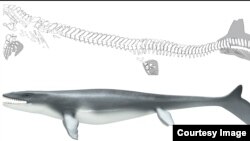It was a lizard with a shark-like fin. That’s what Swedish researchers have discovered about the fearsome mosasaur Prognathodon, which lived in the seas of the Cretaceous Period about 70 million years ago.
The discovery was based on a fossil found in Jordan in 2008. Researcher Johan Lindgren, of Lund University in Sweden, travelled to Jordan in 2011 and discovered that imprints of soft tissue had been preserved around the creature’s tail fin, which ultimately led to the conclusion about its shape. The fossil proved to be the first one of its kind that revealed the tail fin contour in its entirety. But unlike a shark fin, the mosasaur’s fin faced downward
“After trying to reconstruct the tail fin for years, with only the skeleton to go by, I was suddenly standing in front of the definitive answer”, said Johan Lindgren, who lead the international group of Jordanian and American researchers involved in the discovery. “It was a fantastic feeling of euphoria.”
The mosasaur, which could grow up to 17 meters in length, was previously thought to have a long, rectilinear body and a straight, elongated tail. Instead, it has a streamlined, fish-like body with a fluked tail. This is more in line with other big marine creatures, such as the extinct ichthyosaurs (250-94 million years ago) and today’s sharks and whales.
“These characteristics demonstrate in an outstanding way how organisms living in similar environments develop similar features, in a process known as convergent evolution”, said Lindgren.
He points out that the mosasaur’s evolutionary history – not just this discovery but in general – is one of the best examples of large-scale evolution and how animals change appearance in order to adapt to a new environment. In this case, mosasaurs adapted to a marine life following life on land.
The discovery was based on a fossil found in Jordan in 2008. Researcher Johan Lindgren, of Lund University in Sweden, travelled to Jordan in 2011 and discovered that imprints of soft tissue had been preserved around the creature’s tail fin, which ultimately led to the conclusion about its shape. The fossil proved to be the first one of its kind that revealed the tail fin contour in its entirety. But unlike a shark fin, the mosasaur’s fin faced downward
“After trying to reconstruct the tail fin for years, with only the skeleton to go by, I was suddenly standing in front of the definitive answer”, said Johan Lindgren, who lead the international group of Jordanian and American researchers involved in the discovery. “It was a fantastic feeling of euphoria.”
The mosasaur, which could grow up to 17 meters in length, was previously thought to have a long, rectilinear body and a straight, elongated tail. Instead, it has a streamlined, fish-like body with a fluked tail. This is more in line with other big marine creatures, such as the extinct ichthyosaurs (250-94 million years ago) and today’s sharks and whales.
“These characteristics demonstrate in an outstanding way how organisms living in similar environments develop similar features, in a process known as convergent evolution”, said Lindgren.
He points out that the mosasaur’s evolutionary history – not just this discovery but in general – is one of the best examples of large-scale evolution and how animals change appearance in order to adapt to a new environment. In this case, mosasaurs adapted to a marine life following life on land.









